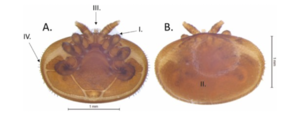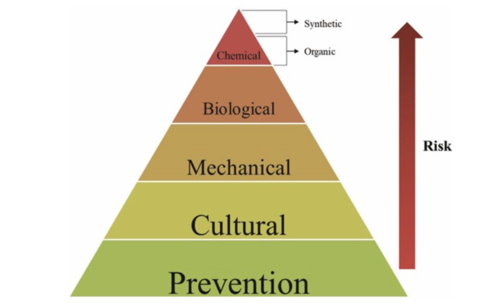Maladies in Honey Bees and Resistance to Varroa Mites
Introduction
Apiculture is a complex trade of raising honeybee colonies. One of the main challenges in this occupation is the many maladies that honey bees face. Throughout history, beekeepers have worked to solve the problems plaguing their bees. These solutions range from chemicals to selective breeding for bees that have a tolerance for specific parasites. One example of such maladies is the Varroa mite which can be treated with chemicals but there is a movement towards choosing branches of honey bees that are hardier when it comes to dealing with mites. Learning about the maladies of bees and keeping up on the new treatments discovered is an essential step for all beekeepers new and experienced. This is because when a beekeeper treats their domesticated bees for a malady, they end up helping the surrounding community of other colonies as well as native populations. Many of these diseases and parasites are transferable from hive to hive and can be deadly to the colony if left untreated. Therefore, the correct handling of these issues can have a positive impact on the native populations[1].

Varroa destructor
Varroa destructor commonly known as the Varroa mite is one of the biggest threats to the beekeeping world currently, affecting both the beekeeping economy and contributing to the rapid decline in beekeeping populations. It is a parasite and a disease vector and can be deadly to a hive[2].
The Varroa mite is a reddish-brown arachnid and can be seen with the naked eye (Fig. 1). They have a dorsal shield and their legs have specialized structures that allow for easy adherence to the host bee (Fig. 2). The mites show sexual dimorphism with the female mite being significantly larger than the male[3].

The first reported case of Varroa was in the Asian Honeybee in 1904 and by 1963 it had made its way to Hong Kong[4]. From there it entered the international honeybee trade and spread around the world. Therefore when Varroa reached the European Honeybee, they did not have defenses against the parasite.
One of the most important things to know when treating the Varroa mite is its life cycle. This life cycle is split into two phases: reproductive and dispersal. At the beginning of the reproductive cycle, a female mite enters an uncapped brood cell containing honeybee larvae at the beginning of the pupae stage. Once the cell is capped, the mite will puncture a hole in the prepupae from which to feed. While it was previously believed that the mites feed on the bee’s hemolymph, it has recently been discovered that they actually feed on the bee’s body fat[5]. The female mite then lays eggs around this feeding area. When the new mites emerge, they immediately mate with each other and therefore emerge from the cell fertilized. When the bee emerges from its cell, attached to it are the mother and daughter mites (the males often are often removed from the food source after fulfilling their duty of mating and therefore die before emergence). From there the mites continue to feed off of the adult bee and sometimes transfer to other bees until it is time to enter another cell and create the next generation[4].
Deformed Wing Virus
While the parasites themselves weaken bees greatly, another major problem they cause is virus transmission due to their transfer between bees. They acquire the pathogen by ingesting it through the fatty tissues that they feed off of. Then the mite will transfer onto a different bee and begin to feed off of it and introduce the pathogen. One of the know viruses that have a direct connection to Varroa is Deformed Wing Virus (DWV). DWV is an icosahedral virus containing a single positive-stranded RNA [6].
Symptoms of DWV include crumpled wings, smaller bodies, discoloration, and shortened life spans (Fig. 1) [1]. This virus is often found in correlation with Varroa mite infestations as, unlike other honey bee viruses, it moves slowly and allows the brood to continue to grow while infected. This allows the mites to develop on the growing brood and pass on the virus. And this virus is not uncommon. In French apiaries, the presence of DWV was found in 90% of hives and in 100% of Varroa mites[6]. Furthermore, it has been discovered that the DWV host range is broadening. It is now known to affect 65 known species from honeybee-like species such as bumblebees to arthropods and arachnids. Therefore, the problem caused by Varroa mites and the viruses they transmit has become a problem not just for domestic honeybees but for the broader ecological community [7].
Artificial Selection and Varroa Resistant Breeds
Beekeepers and scientists have been hard at work trying to find solutions for the epidemic of DWV and its vector the Varroa mite[8]. Over the years, different types of treatments have been proposed, each with a different level of efficacy and risk (Fig. 3)[9]. Prevention is the strategy of avoiding the conditions that allow pest populations to grow to dangerous levels. Since there is no way to remove the conditions that the mites thrive in since those are the bees themselves and the necessary brood chambers, prevention is mainly focused on preventing the spread to different populations. This can entail swarm control and prevention of honey robbing which is when bees from another hive or other insects enter a hive with the intention of stealing honey which can result in mites transferring hosts. While prevention is the safest method of management, it must be used in tandem with other methods.

Mechanical management entails finding ways to physically remove the mites from the hive. One way this can be done is by removing the drone brood, as it is preferred by the mites. However, this method requires the loss of many drones, is labor-intensive, and once again must be used along with other methods.
Biological control involves introducing a natural predator to the parasite while leaving the host unharmed. While there have been tests involving different fungi and bacteria, none of them have succeeded in lowering mite populations while not harming the honeybees. Therefore at this moment, biological management is not a viable option.
Several chemical treatments have been created, and are the most popular due to their low cost, efficacy, and ease of use. Formic acid is one of the most commonly used chemical treatments as it does not contaminate the honey and usually does not affect adult bees[10]. However, it is not a perfect solution. Formic acid can be known to harm bee brood and its efficacy can vary greatly based on treatment methods such as temperature at the time of treatment and placement of the formic acid. Furthermore, formic acid is a contact poison and can be dangerous for the beekeeper. In addition to the risk, arguably the most important problem with formic acid and most chemical treatments is that they are becoming less effective as Varroa mites have begun to gain resistance to them.
This has led to a search for a more permanent solution. Many believe that this will come in the form of cultural control - artificially selecting breeds of honeybees that are more resistant to Varroa[9]. When selectively breeding for mite resistance there are a few traits that beekeepers look for. One of these is grooming. Grooming is a social behavior between honeybees that can dislodge mites. Another trait is hygienic behavior This is when hygienic worker bees are able to detect infested brood and remove it from the hive. These selectively breeding for these traits has resulted in a few Varroa resistant breeds including the Minnesota Hygenic Bees, the Varroa Sensitive Hygiene Bees, Russian Honey Bees, and the Survival Stock. It has taken decades to successfully isolate these traits, and these breeds of honeybees are still not widespread among commercial beekeepers.
For years this selective breeding was done using only observable behaviors, but recently genes that are believed to be associated with these traits have been identified. It has been discovered that in Varroa resistant populations have different expressions in genes related to olfaction and neuronal sensitivity which are believed to play a role in identifying infested brood cells. This discovery is being used to further selective breeding for these traits and make the selection process more precise [11].
References
- ↑ 1.0 1.1 Chen, Y., Suede, R., “Honey bee viruses” Advances in virus research vol. 70 (2007): 33-80
- ↑ Doebler, Stefanie. "The Rise and The Fall of the Honeybee: Mite infestations challenge the bee and the beekeeping industry." BioScience vol. 50,9 (2000): 738-742.
- ↑ Rosenkranz, Peter, et al., “Biology and control of varroa destructor” Journal of Invertebrate Pathology vol. 103 (2010): S96-S119.
- ↑ 4.0 4.1 Traynor, Kristen., et al., "Varroa destructor: A Complex Parasite Crippling Honey Bees World Wide." PNAS vol. 36,7 (2020): 593-606.
- ↑ Ramsey, Samuel. et al., “Varroa destructor feeds primarily on honeybee fat body tissue and not hemolymph” PNAS vol. 116,5 (2019): 1792-1801.
- ↑ 6.0 6.1 Lanzi, Gaetana, et al. “Molecular and biological characterization of deformed wing virus of honeybees (Apis mellifera L.).” Journal of virology vol. 80,10 (2006):4998-5009.
- ↑ Martin, Stephen J., and Laura E. Brettell. “Deformed Wing Virus in Honeybees and Other Insects.” Annual Review of Virology, vol. 6, no. 1, 2019, pp. 49–69.
- ↑ Wilfert, L., Et al., “Deformed wing virus is a recent global epidemic in honeybees driven by Varroa mites” SCIENCE, vol. 351, 6273 (2016):594-597.
- ↑ 9.0 9.1 Jack, Cameron, et al. "Integrated Pest Management of Varroa destructor (Acari: Varroidae), the Most Damaging Pest of (Apis mellifera L. (Hymenoptera: Apidae)) Colonies" Journal of Insect Science, vol. 21,5 (2021).
- ↑ Underwood, M., Et al., “The effects of temperature efficacy against Varroa destructor (Acari: Varroidae), a parasite of Apis mellifera (Hymenoptera: Apidae)” Experimental & Applied Acarology, vol. 29,303 (2003).
- ↑ Navajas, M., et al. “Differential gene expression of the honey bee Apis Mellifera associated with Varroa destructor infection" BMC Genomics vol. 9,301 (2008).
Edited by Sarah Verner, student of Joan Slonczewski for BIOL 116 Information in Living Systems, 2022, Kenyon College.
